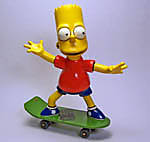Well, it seems like some nice conversation has been going on here

Anyway:
I did some spraying on this little Tiggy last week saturday and today:
I sprayed most of the interior and the tranny and trannycover in Tamiya Hull Red, mixed with a little bit of X-22. The upper sides of the interior got a bit of Vallejo Off White mixed with some little bit of different brown to try to simulate some Elfenbein color. The paint could set for a week and today I painted some details like the radio, seats, steering well etc.
Now, the interior isn't really tidy painted and I could have added some wiring to the radio and extra detailing to the inside, but since pretty much nothing will be seen, I didn't bother to do so. Next step is sealing up the interior and doin' some washes. No real chipping though, since this Tiger didn't last very long.
I also painted the wheels and lower hull already in a mix of Tamiya Dark Yellow, Buff and Brown Earth. This color is a bit darker than the one I'll be using on the upper hull. The tracks got some paint too, but no photos of them.




That's it for the paintjob
Also, some time ago Spit send me a PM mentioning that Voyager Models had some new goodies which were interesting: the snorkel cover and exhausts for an Initial Tiger II...so I immediately went to the Luckymodel site and scored a set

Cheers








































